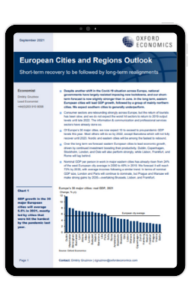European cities short-term recovery to be followed by long-term realignments

Despite another shift in the Covid-19 situation across Europe, national governments have largely resisted imposing new lockdowns, and our short-term forecast is now slightly stronger than in June. In the long term, eastern European cities will lead GDP growth, followed by a group of mainly northern cities. We expect southern cities to generally underperform.
What you will learn:
- Consumer sectors are rebounding strongly across Europe, but the return of tourists has been slow, and we do not expect the worst hit sectors to return to 2019 output levels until late 2022.
- Of Europe’s 30 major cities, we now expect 10 to exceed to pre-pandemic GDP levels this year.
- Over the long term we forecast eastern European cities to lead economic growth, driven by continued investment boosting their productivity.
{% video_player “embed_player” overrideable=False, type=’scriptV4′, hide_playlist=True, viral_sharing=False, embed_button=False, autoplay=False, hidden_controls=False, loop=False, muted=False, full_width=False, width=’1920′, height=’1080′, player_id=’56977904197′, style=” %}
Tags:
Related Services

Post
House prices continue to slide for China’s cities
Research Briefing European cities short-term recovery to be followed by long-term realignments While the property market downturn has been universal, the scale and depth has been varied for different cities and regions.
Find Out More
Post
The Construction Productivity Challenge in Australia
Delve into the state of construction productivity in Australia. Understand the factors affecting growth and how innovation can transform the industry for the better.
Find Out More